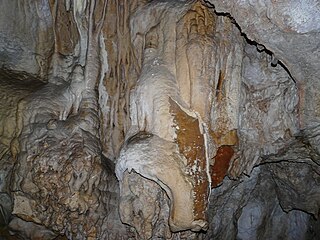Hundalm ice cave
| Hundalm ice cave
|
||
|---|---|---|
|
Stalactite formation |
||
| Location: | Angerberg , Tyrol | |
| Height : | 1515 m above sea level A. | |
|
Geographic location: |
47 ° 32 '42 " N , 12 ° 1' 35" E | |
|
|
||
| Cadastral number: | 1266/1 | |
| Geology: | Wetterstein lime | |
| Type: | Dripstone cave with ice formations | |
| Discovery: | 1921 | |
| Show cave since: | 1967 | |
| Lighting: | Carbide lamp | |
| Overall length: | 264 m | |
| Level difference: | 55 m | |
| Length of the show cave area: |
180 m | |
| Particularities: | Common occurrence of ice and stalactites | |
| Website: | Regional association for caving in Tyrol | |
The Hundalm ice and stalactite cave is located on the Hundalm in the municipality of Angerberg north of Wörgl in Tyrol . The entrance is at 1515 m above sea level. The cave can be reached via marked paths both from the Inn Valley via the Buchackeralm and from Hinterthiersee via the Köglalm. It is the only ice-bearing cave in Tyrol that is accessible to tourists and offers guided tours in the summer months.
geology
The area around the Hundalm is made up of light-colored Wetterstein limestone and heavily deformed, medium-gray main dolomite . The softer rocks of the Raibler strata located in between were tectonically squeezed out and are only found in small remnants. Sandstones, conglomerates and fossil-bearing carbonate rocks, which belong to the Gosau group , lie on top of these limestone rocks . The Hundalm ice and stalactite cave, as well as all other caves known there, formed in the Wetterstein limestone, which also has clear karst forms on the surface (especially carts ).
Discovery and Exploration
The entrances to these mostly shaft-shaped caves in the alpine pasture area around the Hundalm were certainly known to the farmers for a long time. The Hundalm ice and stalactite cave was only known to have been used for the first time in 1921 by Oskar Hossé and Leo Weirather, who entered through the main shaft using wire rope ladders. After that it became quiet again around this cave. In 1956 it was declared a natural monument. The State Association for Speleology in Tyrol, based in Wörgl, expanded the cave into a tourist-accessible show cave, which was opened in 1967 as the first show cave in Tyrol. From 1969 to 1970 the "Viktor Büchel Researcher Hut" was built as a permanent shelter for the guides next to the cave (1520 m above sea level). In 1984 an ice-free deeper part of the cave was discovered, but it is not open to the public.
Cave description
The cave is laid out like a shaft and the entrance is the highest point of the system. The 180-meter-long guide path leads first into the main cavity space that beautiful ice sculptures and up to several meters powerful ground ice has. At the southern end of the cave there are stalactites , which are mostly inactive and z. T. are in the process of destruction. Investigations of such sinter samples have shown ages between 120,000 and older than 350,000 years. The guide path then leads in a tour to the deepest point of the show cave (35 meters below the entrance), where the deepest and oldest ice can be viewed. Judging from a piece of wood that was found in this ice and dated using the radiocarbon method , this ice is about 1300 years old. The deeper part of the cave, which is not accessible to tourists, consists of a north-south oriented main passage with a small lake; Due to the higher temperature in this part of the cave, there is no ice.
literature
- Peter R. Hofmann: Inntaler Unterwelten. Four paths, four caves, four experiences. Books on Demand, Norderstedt 2011, ISBN 978-3-8423-5632-0 .
- Christoph Spötl: The Hundalm ice and stalactite cave. In: Renate Tobitsch, Hannes Kogler, Wolfgang Sieberer (Red.): Festschrift 50 Years of the State Association for Speleology in Tyrol. Landesverein für Höhlenkunde in Tirol, Wörgl 2002, pp. 43–51 ( Speleological communications of the Landesverein für Höhlenkunde 54).
- Robert Bouchal, Josef Wirth: Cave Guide Austria - Over 100 caves with sketches, plans, access descriptions and 150 photos . Pichler Verlag, Vienna 2001, ISBN 3-85431-234-2 , pp. 238-240.
- Herbert Kuntscher: Caves, mines, healing springs. Volume 1: In Tyrol and Vorarlberg. Steiger, Berwang / Tirol 1986, ISBN 3-85423-040-0 .
Web links
Individual evidence
- ↑ Christoph Spötl: Dating of stalactites from the Hundalm ice and stalactite cave. In: Speleological communications of the State Association for Speleology in Tyrol. 57, 2005, pp. 5-9.
- ↑ Rudolf Pavuza, Christoph Spötl: New research from the Hundalm ice cave (1266/1). In: Speleological communications of the State Association for Speleology in Tyrol. 51, 2000, pp. 3-10.


